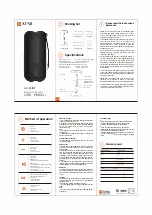
NOTE: Once you have located the ideal speaker position you should mark it. A small tack or
piece of tape can be placed on the carpet so that your ideal listening spot can be easily
relocated when the speakers (or chair) are moved for cleaning, etc. In the event that your
ideal listening spot is inconvenient from the standpoint of the room layout and decor, simply
slide the speakers wherever they look best. Experience has shown that the speakers can be
placed close to a wall, and it will make little difference for FM or background listening.
The entire placement procedure may seem like a great deal of work, but is necessary in the
setup of any high quality system. The time and effort expended should be necessary only
once, and will repay the owner with countless hours of musical enjoyment.
8.
ROOM ACOUSTICS
Magneplanars, like other bipolar speakers, usually sound best with a moderately reflective
surface behind the speakers. In situations where the speakers must be placed as close as 2
feet from the back wall, a heavy damping material directly behind the speakers is advised;
however, it should not cover the entire wall.
Damping material in other parts of the room is a matter of trial and error. A word of caution-
when audiophiles discover the effectiveness of damping material, they sometimes overdo it
(on the premise that if a little is good, more is better). Before you make a permanent change
to your room, experiment with the positioning of the damping material. Usually a portion of
one of two parallel walls should have some damping.
An overdamped room will provide very precise imaging, but you will have a reduced sense of
ambience (less reverberation, spaciousness, air, etc.). An underdamped room may heighten
the illusion of being in a concert hall, but the imaging will seem imprecise with all the
instruments mixed together. Be aware that so-called hardness or overbright sound is usually
the result of a room with hard surfaces (glass, hard paneling, etc.). Moderation is the word.
9.
OPTIONAL TWEETER ATTENUATION
There are two principal reasons for needing to attenuate the Magneplanar Quasi Ribbon
Tweeter:
A.
Recordings, typically in the "pop" or "rock" vein, often exhibit pronounced rise in
the treble region.
B.
The Magneplanar Quasi Ribbon Tweeter is very efficient in its total "energy dispersion." If
the surrounding walls are exceptionally reflective, the overall perceived
acoustical balance will be tipped towards a "hot" high end. Attenuation is
performed through insertion of a simple non-inductive resistor in series with the
tweeter. See Figure 5. Replace the left-hand jumper with the appropriate
resistor to obtain the desired tweeter attenuation. The pair of 1 ohm non-
inductive resistors will attenuate the tweeter 1-2dB. Other values are available
from your Magneplanar dealer.
Содержание MG1.6
Страница 6: ...Figure 3 Figure 4...



























